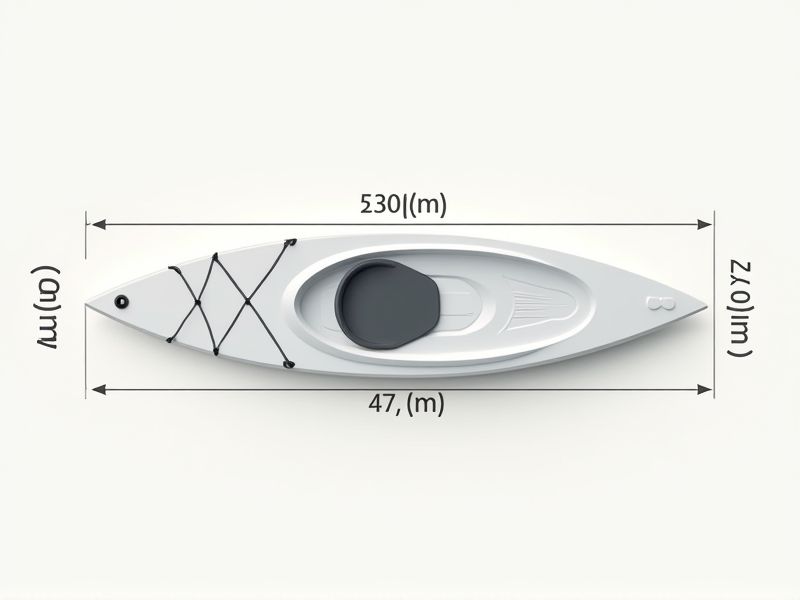
Kayaks come in a range of standard dimensions depending on their intended use, such as recreational, touring, or whitewater activities. Recreational kayaks, for example, are generally about 10 to 12 feet long and 27 to 30 inches wide, making them stable and user-friendly for beginners. Touring kayaks tend to be longer--around 12 to 17 feet--and narrower, at roughly 22 to 25 inches wide, which helps them track straight and move efficiently through the water. Understanding these standard dimensions can help you choose a kayak that fits your needs and skill level, ensuring a more enjoyable paddling experience.
Length: Determines Speed And Storage Capacity.
Kayak length significantly influences both speed and storage capacity, with longer models, typically ranging from 12 to 18 feet, offering enhanced tracking and faster speeds on water. Conversely, shorter kayaks, usually between 8 to 12 feet, provide greater maneuverability, making them ideal for navigating tight spaces and quick turns. For storage, consider that a longer kayak may require more storage space at home or during transport, whereas shorter kayaks are more portable. Understanding these dimensions helps you choose the right kayak for your specific activity, optimizing your performance and convenience.
Width: Affects Stability And Maneuverability.
The width of a kayak, typically ranging from 24 to 36 inches, significantly influences its stability and maneuverability. Wider kayaks provide enhanced stability, making them ideal for beginners or for flatwater paddling, as they reduce the risk of tipping. In contrast, narrower kayaks, often between 21 to 24 inches, allow for greater speed and easier maneuvering in rough waters, appealing to experienced paddlers seeking agility. When choosing a kayak, consider how the width aligns with your paddling style and the type of waters you'll navigate.
Depth: Influences Comfort And Gear Space.
The depth of a kayak, typically ranging from 10 to 15 inches, plays a crucial role in determining your overall comfort and gear space. A deeper kayak offers increased stability and enhances your confidence while paddling in rough waters. Conversely, shallower designs may provide better maneuverability and ease in entry and exit but could compromise storage capacity for your equipment. When selecting a kayak, consider how the depth aligns with your intended use, ensuring it fits your paddling style and gear needs effectively.
Cockpit Size: Impacts Entry, Exit, And Fit.
Cockpit size in kayaks plays a crucial role in your overall experience, significantly affecting entry and exit ease. A smaller cockpit may provide better control and stability, while a larger cockpit can enhance accessibility, especially for beginners or those with mobility challenges. Standard cockpit dimensions typically range from 24 to 32 inches in length and 16 to 22 inches in width, impacting how snugly you fit inside and your ability to maneuver. Proper fit not only enhances comfort during long paddles but also ensures safety and efficiency in various water conditions.
Weight Capacity: Defines Load-Bearing Limit.
The weight capacity of a kayak is crucial for ensuring safety and stability on the water, typically ranging from 250 to 600 pounds. This limit influences the total gear, paddle, and personal weight you can safely bring along. Choosing a kayak with the appropriate weight capacity enhances performance and maneuverability, preventing capsizing or discomfort. Therefore, when selecting a kayak, always refer to the manufacturer's specifications to match your needs effectively.
Rocker: Affects Tracking And Turning.
Rocker in a kayak significantly influences its handling characteristics, particularly tracking and turning ability. A kayak with a pronounced rocker offers enhanced maneuverability, making it ideal for navigating tight turns and agile movements in rivers or coastal waters. Conversely, a flatter hull design, with less rocker, improves tracking, allowing for straighter paths over long distances. Understanding how rocker affects performance can help you choose the right kayak for your paddling adventures, ensuring an optimal experience on the water.
Hull Shape: Influences Performance And Handling.
The hull shape of a kayak significantly affects its performance and handling characteristics, influencing speed, stability, and maneuverability. A streamlined hull minimizes drag, allowing for swift movement through water, achieving speeds of up to 6 mph for experienced paddlers. Meanwhile, wider hull designs provide enhanced stability, making them ideal for beginners or for use in rough waters. Understanding these designs can help you choose a kayak that best suits your paddling style and conditions.
Bow And Stern Design: Impacts Wave Handling And Speed.
The kayak's bow design significantly influences how well it handles waves, providing enhanced stability in rough water conditions. A pointed bow cuts through the waves more efficiently, reducing drag and allowing for higher speeds during paddling. The stern shape also plays a crucial role, with a flatter stern improving tracking and maneuverability, essential for navigating tight spaces. Optimizing both the bow and stern can result in a kayaking experience that maximizes performance and safety on the water.
Material: Influences Durability And Weight.
The durability of a kayak heavily relies on its material composition, influencing both longevity and performance on the water. Common materials include polyethylene, known for its excellent impact resistance and affordability, and fiberglass, which offers a lightweight option with superior speed and agility. High-end models may utilize carbon fiber, which can reduce weight by up to 30% compared to traditional materials while providing exceptional stiffness. Choosing the right material can significantly enhance your kayaking experience, ensuring safety and enjoyment for years to come.
Seat Design: Affects Comfort And Paddling Efficiency.
The seat design of a kayak plays a crucial role in your overall comfort and paddling efficiency. Ergonomically molded seats often feature adjustable straps and lumbar support, allowing for optimal positioning during long hours on the water. Research indicates that proper seat alignment can enhance paddling power by as much as 15%, reducing fatigue. Choosing a kayak with a well-designed seat tailored to your body type can significantly improve your kayaking experience.
